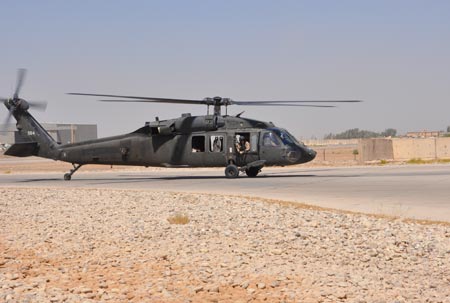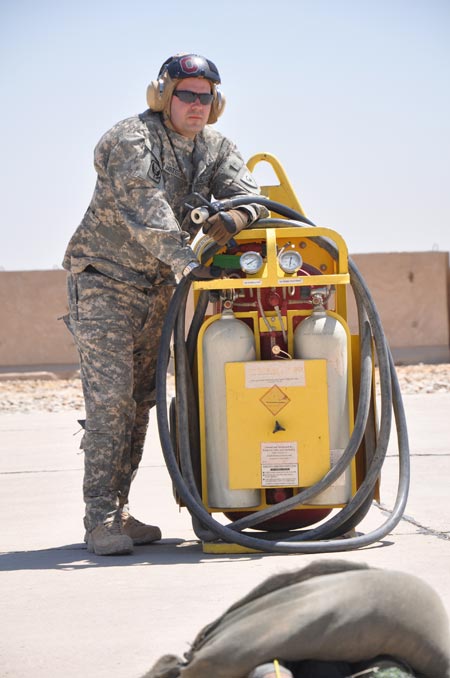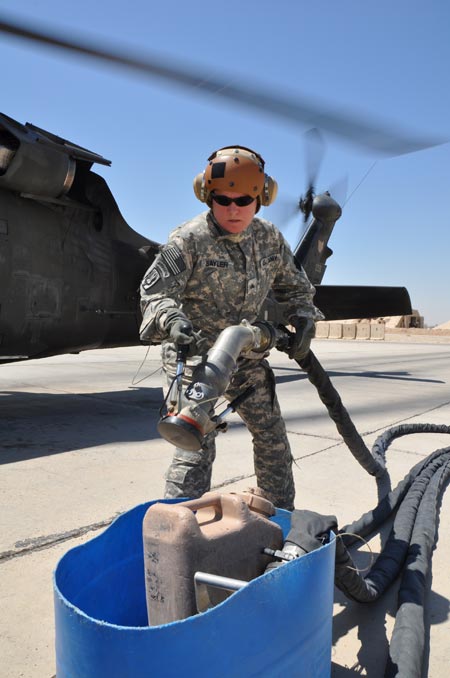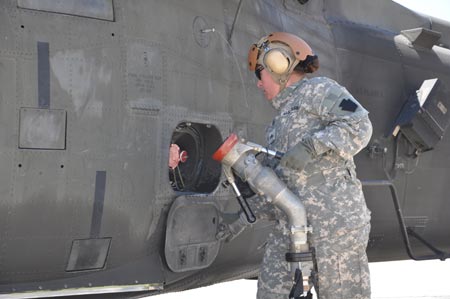The Ohio National Guard at work in IraqAs we enjoy our Labor Day weekend, let us not forget the brave men and women who risk their lives to defend and protect our freedom. The refuelers here don't climb over walls like those on a racecar pit crew, but they do run past six-foot cement T-walls that protect one of the forward area refueling points here. The refueling points are important to Army aviation units throughout Iraq."A FARP expands the combat power of an aviation task force," said Sgt. 1st Class Chip Berg. "It gives the commander the flexibility in his mission assignments. It buys him time." Berg, London, Ohio, is the Riflestock FARP noncommissioned officer in charge.
Like pit crew members, every refueling Soldier has a specific job - a Soldier to refuel the helicopter, a Soldier to man the fire extinguishers, and a Soldier to run the fuel trucks that pump the petroleum. Berg praised his Soldiers, who are with Company E, 1st Battalion, 137th Assault Helicopter Battalion, and who are under his command.
"Fortunately with the crew I got, they know what their jobs are," said Berg. "You don't have to direct them and tell them what to do. They know where to go, and they know what to do." 
A Task Force 38 UH-60 Black Hawk lands at the Riflestock FARP in Baghdad Iraq on on Monday, August 24, 2009. U.S. Army photo by Staff Sgt. Jeff Lowry, Task Force 38 Public Affairs
Though Berg refers to his Soldiers as his crew, he doesn't compare them to a racecar pit crew.
"Our times savings aren't in seconds; our time savings are in minutes," he said.In Army aviation lingo the process of refueling helicopters with the engines on and the blades still turning is known as "hot fuel," and there is a certain amount of risk involved. "I consider this the second most dangerous job in aviation; this first is flying those birds (helicopters)," Berg said. However, the risks of a hot fuel are mitigated as the Soldiers keep aware of their surroundings.
"Just pay attention to everything, and what's going on around you," said Spc. Thomas Masters, of Galloway, Ohio, and an aircraft refueler with Company E. "As long as there are no sparks and the aircraft doesn't catch on fire, then we're good to go." 
Ohio National Guard Spc. Thomas Masters, of Galloway, Ohio, and an aircraft refueler with Company E, stands guard next to fire extinguishers while a UH-60 Black Hawk helicopter is being refueled on Monday, August 24, 2009.
Besides the safety concerns for the air-craft, its crew and the refuelers there are other concerns like for the passengers.
"What I worry more about are the passengers," said Sgt. Robin Sayler, of Eugene, Ore., and an aircraft refueler attached to the company.
Many of the aircraft transport passengers throughout Iraq. Passengers leave the aircraft and head to a safe area behind T-walls before the refueling begins. 
Oregon National Guard Sgt. Robin Sayler, Eugene, Ore., and an aircraft refueler attached to Company E, 1st Battalion, 137th Assault Helicopter Battalion of the Ohio National Guard, replaces a hose after refueling a UH-60 Black Hawk helicopter on Monday, August 24, 2009. U.S. Army photo by Staff Sgt. Jeff Lowry, Task Force 38 Public Affairs
Sayler has a son who is a Soldier, and he is heading to Iraq soon. She stated her motherly instincts take over when looking after the passengers during the refueling process.
"My son could be on that bird; my brother is a contractor so he could be too," she said. 
Oregon National Guard Sgt. Robin Saylor, Eugene, Ore., and an aircraft refueler attached to Company E, 1st Battalion, 137th Assault Helicopter Battalion of the Ohio National Guard, finishes fueling a UH-60 Black Hawk helicopter on Monday, August 24, 2009. U.S. Army photo by Staff Sgt. Jeff Lowry, Task Force 38 Public Affairs
Berg repeated the sentiments of his Soldiers that they need to stay safe to complete the mission. "As long as we're efficient and safe we're going to get the job done, and they're going fly away," he said. Story by Staff Sgt. Jeff Lowry, Task Force 38 Public Affairs
Top of Page
Back to Memories for Cleveland Seniors
|